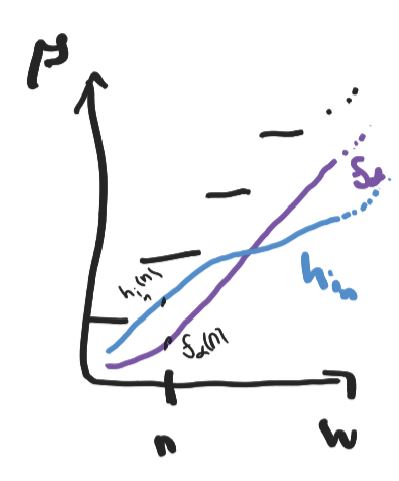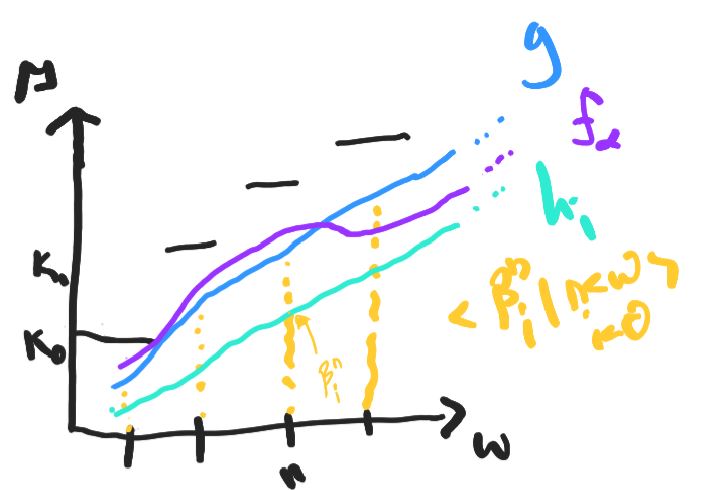Baumgartner Type
Let $S\subseteq \mathop{\mathrm{acc}}(\omega_1)$, fix a ladder system $\langle C_\alpha \mid \alpha\in S \rangle$ such that for every $\alpha \in S$, the ladder $C_\alpha$ is cofinal in $\alpha$ with order-type $\omega$. We will abuse the notation and let $C_\alpha(n)$ for $n<\omega$ denote the unique $\beta\in C_\alpha$ such that $\mathop{\mathrm{otp}}(C_\alpha\cap \beta )=n$. Consider the the set $L_S:=\{C_\alpha \mid \alpha\in S\}$ ordered by the lexicographic order, we will call such a linear order a Baumgartner type. The set $S$ will be called the support.
We begin with the following usefull Lemma about Baumgartner types.
Lemma 1. For every stationary subset $T\subseteq \omega_1$, there are two disjoint stationary subsets $T^-,T^+\subseteq T$ such that for all $f^-\in L_{T^-}$ and $f^+\in L_{T^+}$, $f^-<_{\mathop{\mathrm{lex}}} f^+$.
Proof.
We construct by recursion on $n<\omega$ a decreasing sequence $\langle T_n \mid n<\omega \rangle$ of stationary subsets of $T$. At the base stage let $T_0:=T$. In the $n$-step, using Fodor’s Lemma, define $T_{n+1}$ to be a stationary subset of $T_n$ such that $C_{\alpha}(n)$ is constant for all $\alpha\in T_{n+1}$ with minimal value $c_{n}$. We define the following sets:
Notice that if the set $T^+_{n+1}:=\{\alpha\in T_n \mid C_{\alpha}(n)> c_{n}\}$ is stationary, then we are done as for all $f^-\in L_{T_{n+1}}$ and $f^+\in L_{T^+_{n+1}}$, we have $f^-<_{\mathop{\mathrm{lex}}} f^+$.
By the minimality of $c_n$, we get that $T^-_{n+1}:=\{\alpha\in T_n \mid C_{\alpha}(n)< c_{n}\}$ is non-stationary. Clearly $T=D_n\cup U_n \cup T_{n+1}$, $U_n= \bigcup_{m\leq n} T^+_{m+1}$ and $D_n = \bigcup_{m\leq n} T^-_{m+1}$.
Suppose the recursion haven’t stopped along the way. Clearly $\bigcap_{n<\omega} T_{n}$ has at most one element. But this is absurd as $T=(\bigcup_{n<\omega} (D_n \cup U_n)) \cup (\bigcap_{n<\omega} T_{n})$ is non-stationary as it is a countable union of non-stationary sets. $\square$
Recall that a linear order is said to be scattered if it does not contain a copy of the rationals. A linear order is called $\sigma$-scattered if it is a countable union of scattered linear orders, similarly a linear order is called $\sigma$-well ordered if it is a countable union of well-orders.
Theorem 2 (Baumgartner, Therorem 3.7(i)). Suppose $S\subseteq \mathop{\mathrm{acc}}(\omega_1)$.
1) If $S$ is stationary, then $L_S$ is not $\sigma$-scattered.
2) If $S$ is not stationary, then $L_S$ is $\sigma$-well ordered.
It is easy to check that a well ordered set is scattered, so we get the following Corollary:
Corollary 3. The linear order $L_S$ is $\sigma$-scattered if and only if $S\subseteq \mathop{\mathrm{acc}}(\omega_1)$ is not a stationary subset.
Let us now prove the theorem.
Proof.
1) Suppose $S\subseteq \mathop{\mathrm{acc}}(\omega_1)$ is a stationary set, we will show that $L_S$ is not $\sigma$-scattered, i.e. $L_S$ cannot be represented as a countable union of scattered linear orders.
Suppose we are given a countable partition of $S$, $\langle S_i \mid i<\omega \rangle$. As $S$ is stationary, we can find some $i<\omega$ such that $S_i$ is also stationary.
We claim that it is possible to embed the rationals, i.e. $({}^{<\omega}2, \leq_{\mathop{\mathrm{lex}}})$ into $L_{S_i}$.
We construct an order-preserving function $f:{}^{<\omega}2\rightarrow L_{S_i}$ by recursion on the length of $s\in {}^{<\omega}2$. At each step of the recursion we will find for a given stationary set $T^s$ two stationary sub-sets $T^{s^\frown 0}, T^{s^\frown 1}$.
$\blacktriangleright$ Base stage $s=\emptyset$: As $S_i$ is stationary, using the Lemma we can find a stationary subsets $R\subset S_i$ and $\alpha\in S\setminus R$ such that $C_\alpha <_{\mathop{\mathrm{lex}}} C_\beta$ for all $\beta\in R$.
Let $f(s)=C_\alpha$ and $T^{s}:= R$.
$\blacktriangleright$ Stage $n$: Suppose $s\in {}^{n}2$. As $T^s$ is stationary, we may use the Lemma twice to find two disjoint stationary subsets $T^{s^\frown 0},T^{s^\frown 1}\subseteq T^s$ and $\alpha_0, \alpha_1 \in T^s\setminus (T^{s^\frown i}\cup T^{s^\frown 1})$ such that for all $f^-\in L_{T^{s^\frown 0}}$ and $f^+\in L_{T^{s^\frown 1}}$:
For each $i<2$ let $f(s^\frown i)=C_{\alpha_i}$. Clearly $f$ has the required properties.
2) Suppose $S$ is non-stationary, we will show that $L_S$ is $\sigma$-well ordered. Fix a club $C\subseteq \omega_1$ such that $S\cap C =\emptyset$. We fix an enumeration $\langle c_\beta \mid \beta<\omega_1 \rangle$ of $C$, for convenience we assume $c_0=0$.
For $\alpha\in S$, we let $K(\alpha):=\{ \beta<\omega_1 \mid \exists \gamma\in C_\alpha [ c_\beta\leq \gamma < c_{\beta+1}] \}$, clearly $K(\alpha)$ is finite.
For each $\beta<\omega_1$, consider the set $S_\beta:=\{ C_\alpha \cap \beta \mid \alpha \in S \}$. Notice that $S_\beta\subseteq [\beta]^{<\omega} \cup \{ C_\alpha \mid \alpha \in S\cap \beta\}$ which is countable and fix a witnessing bijection $f_\beta :S_\beta\rightarrow \omega$.
We define a function $G:S\rightarrow {}^{<\omega} \omega$ as follows: Fix $\alpha\in S$. Suppose $n= |K(\alpha)|$ and $K(\alpha)=\{\beta_1,\dots, \beta_n\}$. For each $1\leq i\leq n$, let $m_i:=f_{\beta_{i+1}}(C_\alpha\cap \beta_{i+1})$. Define $G(\alpha):=(n,m_1,\dots, m_n)$.
As ${}^{<\omega} \omega$ is countable, the following claim will give us that $L_S$ is $\sigma$-well ordered.
Claim. For every $t\in {}^{<\omega} \omega$, the set $\{C_\alpha \mid G(\alpha)=t\}$ is well-ordered.
Subproof.
Fix $t=(n,m_1,\dots, m_n)$ and a $<_{\mathop{\mathrm{lex}}}$-decreasing sequence $\{C_{\alpha_k}\mid k<\omega \}$ such that for every $k<\omega$ we have $f(\alpha_k )=t$. We will show that the sequence must become constant from some point.
For each $k<\omega$, let $K(\alpha_k) :=(\beta^k_1,\dots,\beta^k_n)$. We use finite induction on $1\leq i\leq n$ to show that we can find some $k_i<\omega$ large enough such that for all $m>k_i$, we have $\beta^m_i = \beta^{k_i}_i$ and moreover $C_{\alpha_m} \cap \beta^{k_i}_i = C_{\alpha_{k_i}} \cap \beta^{k_i}_i$.
$\blacktriangleright$ Base stage: Let $k<\omega$, notice that $C_{\alpha_{k+1}} <_{\mathop{\mathrm{lex}}} C_{\alpha_{k}}$ imply that $\beta^{k+1}_1 \leq \beta^{k}_1$. As the ordinals are well-ordered, we can find some $k_1<\omega$ such that $\beta^m_1$ is constant for all $m\geq k_1$.
By $f_{\beta_1}$ definition and the fact that $G(\alpha_m)$ is constant, we get that $C_{\alpha_m} \cap \beta^{k_1}_1 = C_{\alpha_{k_1}} \cap \beta^{k_1}_1$.
$\blacktriangleright$ $i+1$-stage: We follow the same strategy as in the base stage. Notice that for $m\geq k_i$, we know that $C_{\alpha_{m+1}} <_{\mathop{\mathrm{lex}}} C_{\alpha_{m}}$ and $C_{\alpha_m} \cap \beta^{k_i}_i = C_{\alpha_{k_i}} \cap \beta^{k_i}_i$, which imply that $\beta^{m+1}_{i+1}\leq \beta^{m}_{i+1}$.
Again as the ordinals are well-ordered, we can find some $k_{i+1}<\omega$ such that $\beta^m_{i+1}$ is constant for all $m\geq k_{i+1}$. By $f_{\beta_i}$ definition and the fact that $G(\alpha_m)$ is constant, we get that $C_{\alpha_m} \cap \beta^{k_{i+1}}_{i+1} = C_{\alpha_{k_{i+1}}} \cap \beta^{k_{i+1}}_{i+1}$.
Finally, we got that $C_{\alpha_m} = C_{\alpha_{k_n}}$ for every $m>k_n$, hence $\{C_\alpha \mid G(\alpha)=t\}$ is well-ordered by the lexicographic order as wanted. $\blacksquare$ ◻
It turns out that the support of a Baumgartner type is a useful invariant. The following Proposition is used in the proof of [Lamei Ramandi, Proposition 2.8].
Proposition 4. Suppose $X,Y\subseteq \mathop{\mathrm{acc}}(\omega_1)$ are two stationary subsets, $X\setminus Y$ is stationary, $L_X =\{ x_\alpha \mid \alpha\in X \}$ and $L_Y =\{ y_\alpha \mid \alpha\in Y \}$ are Baumgartner type, then there is no $<_{\mathop{\mathrm{lex}}}$-order preserving embedding from $L_X$ to $L_Y$.
Proof. Suppose $f:L_X\rightarrow L_Y$ is a $<_{\mathop{\mathrm{lex}}}$-order preserving function. Notice that the stationary set $Z:=X\setminus Y$ is the union of the two sets:
Clearly one of them is stationary, we will show that this leads to a contradiction.
$\blacktriangleright$ Suppose $S_0$ is stationary, then by Fodor’s Lemma, there exists some $\beta\in Y$ and a stationary subset $Z_0\subseteq S_0$ such that $f(x_\alpha) = \beta$ for every $\alpha \in Z_0$. But this is absurd, as $f$ is an order-preserving embedding.
$\blacktriangleright$ Suppose $S_1$ is stationary. By Corollary 2 we get that $\{x_\alpha \mid\alpha \in S_1\}$ in not $\sigma$-scattered. Hence, the isomorphic linear order $\{f(x_\alpha) \mid \alpha \in S_1 \}$ is also not $\sigma$-scattered. By Corollary 2, we get that the support $A=\{\beta\in Y \mid \exists \alpha \in S_1[ f(x_\alpha)=y_\beta]\}$ is stationary. Notice that for every $\beta \in A$, we have that for some $\alpha<\beta$ we have $f(x_\alpha)=y_\beta$. Then by Fodor’s Lemma, there exists some $\alpha\in Z$ and a stationary subset $B\subseteq A$ such that $f(x_\alpha) = \beta$ for every $\beta \in B$. But this is absurd, as $f$ is an order-preserving embedding. ◻
Corollary 5. There are $2^{\aleph_1}$ many non-isomorphic Baumgartner types of linear orders.
Proof. Fix by Ulam theorem a partition of $\mathop{\mathrm{acc}}(\omega_1)$ to $\omega_1$ many disjoint stationary subsets, $\langle S_\alpha \mid \alpha<\omega_1 \rangle$. Also fix a $C$-sequence, i.e. a ladder system $\langle C_\alpha \mid \alpha\in \mathop{\mathrm{acc}}(\omega_1) \rangle$ such that for every $\alpha \in S$, the ladder $C_\alpha$ is cofinal in $\alpha$ with order-type $\omega$.
For every $A\subseteq \omega_1$, we consider the linear order $L^A:= \{ C_\alpha \mid \alpha \in \bigcup_{\alpha\in A} S_\alpha\}$ ordered by the lexicographic order $<_{\mathop{\mathrm{lex}}}$. Notice that by the above Proposition for every two different $A,B\subseteq \omega_1$, we have that $L^A$ is not isomorphic to $L^B$. ◻

